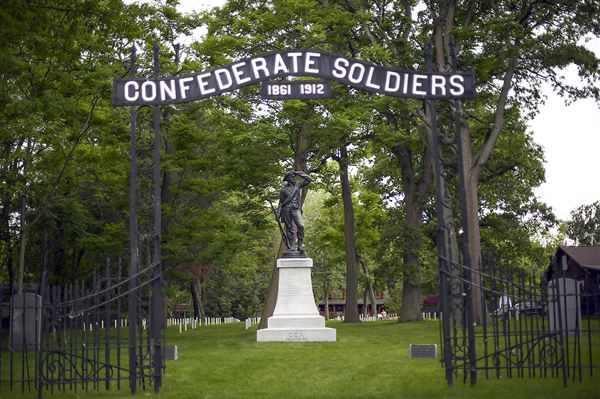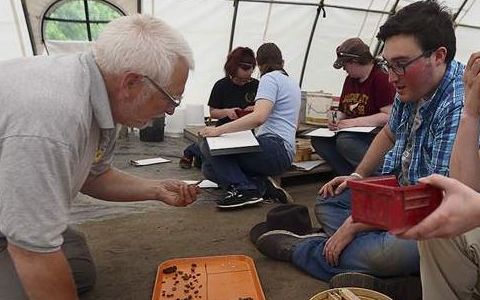SANDUSKY, Ohio — Just beyond the wrought iron gate, a Confederate soldier grasping a rifle holds a hand up to shade his face as he scans the horizon.
The Lookout, sculpted by Moses Ezekiel, guards the Confederate Stockade Cemetery on Johnson’s Island, the resting place of some 267 Confederate soldiers once held at a nearby prison.
The Johnson’s Island Prison, built during the Civil War in 1862, was the only facility built by the Union solely for the purpose of housing Confederate war captives.
Today, the prison persists both as a cemetery and an archaeology site. Half a mile from the bronze statue, tidy lawn, and orderly white headstones, Professor David Bush of Heidelberg University and eight volunteers — most of them entering college, in college, or just graduated — are excavating the prison. They started their most recent dig on June 6 and will work for five weeks as part of the university’s Field School.

‘The Lookout’ at Johnson’s Island Confederate Cemetery was sculpted in 1910 by Moses Ezekiel. It has not drawn the controversy that some prominent monuments in Louisiana and elsewhere have had this year.
The prison is quiet while they work. So is the cemetery. Protesters have turned out to both support and oppose the recent removal of Confederate memorials in Louisiana celebrating Robert E. Lee, Jefferson Davis, and P.T. Beauregard. But such protests have not reached Johnson’s Island.
Matthew Rastatter, a history buff from Akron, recently visited the cemetery with his fiancee, Kaitlin Spagnoli. He said he thinks Confederate monuments present a “tough discussion,” but that this one should stay.
Some memorials are clearly objectionable, he said, such as the recently removed Battle of Liberty Place Plaza memorial in Louisiana. The memorial honored a post-war, white-supremacist militia. But memorials like the one on Johnson’s Island are different, Mr. Rastatter said, because they are about individuals, not the Confederacy.
‘The Lookout’ at Johnson’s Island Confederate Cemetery was sculpted in 1910 by Moses Ezekiel. It has not drawn the controversy that some prominent monuments in Louisiana and elsewhere have had this year.
“They were young people that had dreams and thoughts and desires and wanted to grow old, but unfortunately couldn’t do that — on both sides. So I think it’s important that we memorialize the people.”
Mr. Bush has worked on the site 30 years, digging up and mapping 5 percent of it. This time along, he and his team will excavate part of a “block” — the buildings which housed prisoners — and a latrine.
One of the diggers, Gabriel Feazell, is descended from a former prisoner, Robert M. Smith — a connection about which Professor Bush notified Mr. Feazell’s father.
Smith, who Mr. Bush has dubbed the prison’s “MacGyver,” kept busy: He photographed prisoners in the camp and carved hard rubber into jewelry. Photography and jewelry-making were not typical pastimes for Civil War prisoners.
Mr. Feazell’s father donated a rubber ring inlaid with gold and seashells to the dig. Mr. Feazell is reading Smith’s journals, and feels some connection to his ancestor.
When the team finishes each day, it catalogues all that it has found. Crouching by some discovered artifacts and fragments, Mr. Bush scrapes the dirt from a shard of ceramic pottery.
“That’s a nice yellowware piece,” he said. He grabs something else. “That’s globe glass.”
Someone has found a bone fragment — unidentified, but definitely not human. It goes in the bone pile.
Artifacts from the dig are stored at a nearby museum operated by the Johnson’s Island Preservation Society in Sandusky.
The camp initially housed officers and enlisted men, Mr. Bush said, but before long the flow of prisoners was too much to handle and enlisted men were sent elsewhere. The camp’s population thus was affluent, well-educated, and intolerant of boredom.
“They played chess, they had debate societies, they had thespian groups, they played baseball as well,” Mr. Bush said. “They had playbills that would basically advertise what they would be doing.”
One playbill recovered from the site describes a performance by the “Rebellonians.” It was made up of musical selections and a skit called the “fashionable ball.”
Now 152 years later, the prison site is all quiet. Except for the sounds of digging.



